Flora of New York/Carduoideae
Jump to navigation
Jump to search
| ← Aquifoliaceae, Campanulaceae, Menyanthaceae |
Flora of New York — Asterales : Asteraceae : Carduoideae : Cardueae | → Cichorioideae | |||
| Table of contents |
Genus index |
Protected species index | Invasive species index | ||
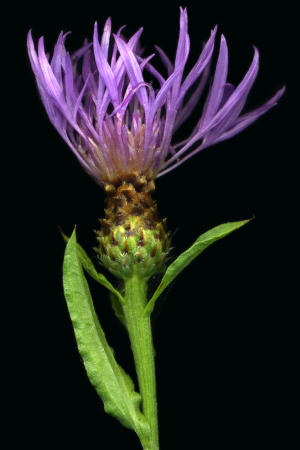 |
Family Asteraceae
[edit | edit source]The Asteraceae (or Compositae)
Subfamily Carduoideae
[edit | edit source]Tribe Cardueae
[edit | edit source]| The Cardueae (syn. Cynareae) is a mostly non-native tribe of Asteraceae. It contains various thistles and knapweeds, many of which are considered highly invasive in the region.
|
Subtribe Carlininae
[edit | edit source]Carlina
[edit | edit source] |
| Genus Carlina | Carline-thistle | N.Y. Status | Images | Distribution | NY NPT |
| ssp. vulgaris 1753. Carlina vulgaris L. in…
1782. Carlina caulescens Gilib. in…
1824. Carlina longifolia Viv. in…
1829. Carlina vulgaris var. uniflora Gaudin in…
1907. Carlina flavispina Simonk. in… |
Carline thistle ⓘ |
Introduced from Europe to Iran, Naturalized |

|
NYFA: X NYFA: 5 counties iNat 6 counties |
USDA-X0 POWO BONAP Images Wikispecies |
|
| |||||
Subtribe Echinopsinae
[edit | edit source]Echinops
[edit | edit source] |
| Genus Echinops | Globethistle | N.Y. Status | Images | Distribution | NY NPT |
L. ssp. sphaerocephalus1753. Echinops sphaerocephalus L. in…
1771. Echinopus sphaerocephalus (L.) Scop. in…
1796. Echinops maximus Siev. in…
1838. Echinops giganteus DC. in…
1889. Echinops major St.-Lag. in…
1891. Sphaerocephalus multiflorus Kuntze in… |
Glandular globe-thistle ⓘ
Great globe thistle ⓘ
|
Introduced from Eurasia, Naturalized, Cultivated, SNA Perennial, Herb-forb |

|
NYFA: X NYFA: 11 counties iNat GBIF 2 counties |
USDA-XX POWO Images Wikispecies |
|
| |||||
Subtribe Carduinae
[edit | edit source]Onopordum
[edit | edit source] |
| Genus Onopordum | Cottonthistle | N.Y. Status | Images | Distribution | NY NPT |
L. ssp. acanthium1753. Onopordum acanthium L. in…
1771. Acanos spina Scop. in…
1791. Acanthium onopordon Gueldenst. in…
1796. Onopordum tomentosum Salisb. in…
1891. Onopordum acanthium var. polycephalum Willk. in…
1896. Onopordum acanthium var. schultesii (Brittinger ex W.D.J.Koch) Rouy in… |
Scotch thistle, Scotch cottonthistle |
Introduced, Potentially invasive, iMapInvasives, Invasive.org: [1], Naturalized, SNA Biennial, Herb-forb |

|
NYFA: X NYFA: 13 counties ? counties |
USDA-XM POWO Go Botany Images Wikispecies |
|
| |||||
Arctium
[edit | edit source]| Genus Arctium | Burdock | N.Y. Status | Images | Distribution | NY NPT |
L. ssp. lappa1753. Arctium lappa L. in…
1762. Lappa vulgaris Hill
1785. Lappa officinalis All.
1791. Lappa major Gaertn.
1800. Arctium majus Bernh.
1833. Arctium nemorosum Lej. & Court.
1883. Lappa lappa (L.) H.Karst. (i)
1913. Arctium vulgare (Hill) A.H.Evans
1928. Arctium edule Beger |
Greater burdock, Great burdock, Edible burdock, Beggar's-buttons Grande bardane, Bardane majeure, Rhubarbe sauvage, Graquias, Toques, Rapace |
Introduced from Eurasia |

|
NYFA: X NYFA: ? counties ? counties |
USDA-XX Go Botany VASCAN ARS-GRIN ITIS FNA Tropicos Images Wikispecies |
(Hill) Bernh. 1762. Lappa minor Hill
1800. Arctium minus (Hill) Bernh.
1856. Arctium pubens Bab. |
Lesser burdock, Common burdock, Cuckoo-button Petite bardane, Bardane mineure, Bardane, Tabac du diable, Tapace, Chou bourache, Cibourroche, Graquias |
Introduced from Eurasia, northern Africa |

|
NYFA: X |
USDA-XX Go Botany VASCAN ARS-GRIN Tropicos Images Wikispecies |
| Genus Arctium (excluded taxa) | Burdock | N.Y. Status | Images | Distribution | NY NPT |
Mill. 1768. Arctium tomentosum Mill. |
Woolly burdock, Hairy burdock Bardane tomenteuse |
Introduced from Eurasia, N.Y. excluded |

|
NYFA-Excluded |
USDA-XX Go Botany ARS-GRIN FNA BONAP Images Wikispecies |
|
| |||||
Silybum
[edit | edit source]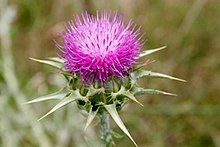 |
| Genus Silybum | Milk thistle | N.Y. Status | Images | Distribution | NY NPT |
(L.) Gaertn. 1753. Carduus marianus L.
1768. Mariana mariana (L.) Hill in…
1791. Silybum marianum (L.) Gaertn. |
Milk-thistle, Blessed milkthistle, St. Mary's thistle |
Introduced from Eurasia, northern Africa, Highly invasive, NYS Tier 5[1] Biennial, Herb-forb |

|
6 counties NYFA: X |
USDA-XX Go Botany ARS-GRIN Images Wikispecies |
Cirsium
[edit | edit source]| Cirsium species are known as plume thistles due to the feathered hairs on their achenes.
|
New-World Cirsium
[edit | edit source] Swamp thistle |
| Genus Cirsium Mill. (1745) (North American - HG1) |
Thistle | N.Y. Status | Images | Distribution | NY NPT |
Michx. 1803. Cirsium muticum Michx.
1807. Carduus muticus (Michx.) Pers.
1814. Cnicus muticus (Michx.) Pursh
1838. Cirsium bigelovii DC. |
Swamp thistle, Dunce-nettle, Horsetops Chardon mutique, Circe mutique |
Native, CoC: 9, Secure, S5, G5 OBL Biennial, Herb-forb |

|
NYFA: 5 |
USDA-NN Go Botany VASCAN ITIS FNA Tropicos BONAP Images Wikispecies |
(Muhl. ex Willd.) Spreng. 1803. Cnicus discolor Muhl. ex Willd.
1818. Carduus discolor in…
1826. Cirsium discolor in…
1894. Cirsium altissimum f. discolor (Muhl. ex Willd.) Voss
1902. Cirsium altissimum var. discolor (Muhl. ex Willd.) Fernald
1917. Cirsium altissimum ssp. discolor (Muhl. ex Willd.) Petr. |
Field thistle, Pasture thistle Chardon discolore, Circe discolore |
Native, CoC: 1, Secure, S5 UPL Biennial-perennial, Herb-forb |

|
NYFA: 5 |
USDA-NN Go Botany VASCAN FNA Tropicos BONAP Images Wikispecies |
(L.) Spreng. 1753. Carduus altissimus L.
1804. Cnicus altissimus Willd.
1826. Cirsium altissimum (L.) Spreng.
1826. Cirsium altissimum (L.) Hill
1908. Cirsium iowense in…
1917. Cirsium altissimum var. biltmoreanum Petr. |
Tall thistle, Roadside thistle |
Native, CoC: 10, Likely extirpated UPL Biennial, Herb-forb |

|
NYFA: Z |
USDA-N0 Go Botany ARS-GRIN ITIS FNA Tropicos BONAP Images Wikispecies |
(Rydb.) Arthur
1900. Carduus flodmanii Rydb.
1903. Cirsium oblanceolatum in…
1912. Cirsium flodmanii (Rydb.) Arthur |
Flodman's thistle, Prairie thistle |
Introduced, Midwest native, Preglacial relict? FAC-FACU Perennial, Herb-forb |

|
NYFA: X |
USDA-NN Go Botany ARS-GRIN FNA BONAP Images Wikispecies |
| Genus Cirsium Mill. (1745) (North American - HG2) |
Thistle | N.Y. Status | Images | Distribution | NY NPT |
(Nutt.) Spreng. ssp. pumilum 1818. Carduus pumilus Nutt.
1826. Cirsium pumilum (Nutt.) Spreng.
1911. Cirsium odoratum in… |
Pasture thistle, Fragrant thistle, Bull thistle Chardon nain |
Native, CoC: 1, Secure N. R. Biennial, Herb-forb |

|
NYFA: 5 |
USDA-N0 Go Botany VASCAN ARS-GRIN ITIS FNA Tropicos BONAP Images Wikispecies |
Michx. var. horridulum 1803. Cirsium horridulum Michx. |
Yellow thistle, Giant thistle, Bristly thistle, Horrid thistle, Bull thistle |
Native, CoC: 5, Rare FACU Annual-biennial, Herb-forb |

|
NYFA: N |
USDA-N0 Go Botany ARS-GRIN FNA BONAP Images Wikispecies |
|
| |||||
Old-World Cirsium
[edit | edit source] bull thistle |
| Genus Cirsium (Eurasian ) | Plume thistle | N.Y. Status | Images | Distribution | NY NPT |
(Savi) Ten. 1753. Carduus lanceolatus L.
1798. Carduus vulgaris Savi
1835. Cirsium vulgare (Savi) Ten.
1938. Ci. vulgare Airy Shaw (hom.)
1972. Ci. lanceolatum Scop. non Hill |
Bull thistle, Common thistle, Spear thistle, Scotch thistle Chardon vulgaire, Chardon lancéolé, Gros chardon, Circe commun, Circe vulgaire |
Introduced from Eurasia, northern Africa, Widespread weed, NE-3[1], Invasive.org FACU Biennial, Hert-forb |

|
NYFA: X |
USDA-XX Go Botany VASCAN ARS-GRIN FNA Tropicos Images Wikispecies |
(L.) Scop. 1753. Serratula arvensis L.
1772. Cirsium arvense (L.) Scop.
1777. Carduus arvensis (L.) E.Robson
1819. Cirsium incanum
1819. Cirsium setosum (Willd.) M.Bieb. |
Creeping thistle, Canada thistle, Field thistle Chardon des champs, Chardon du Canada, Circe des champs |
Introduced from Eurasia, Highly invasive, NYIS: 71%[2], Prohibited[3], CP-2[4] NE-2[5] FACU Perennial, Hert-forb |

|
NYFA: X |
USDA-XX Go Botany VASCAN ARS-GRIN Tropicos Images Wikispecies |
(L.) Scop. 1753. Carduus palustris L.
1772. Cirsium Palustre (L.) Scop. |
Marsh thistle, Marsh plume thistle, European marsh thistle, European swamp thistle Chardon des marais, Cirse des marais |
Introduced from Eurasia, Moderately invasive, NYIS: 68% [6], NE-2[5] FACW Perennial, Hert-forb |

|
NYFA: X |
USDA-XW Go Botany VASCAN ARS-GRIN Tropicos Images Wikispecies |
| |||||
Carduus
[edit | edit source] spiny plumeless thistle |
| Genus Carduus | Plumeless thistle | N.Y. Status | Images | Distribution | NY NPT |
ssp. acanthoides |
Spiny plumeless thistle | Introduced, Moderately invasive |

|
NYFA: X |
USDA-XX Images Wikispecies |
| Musk thistle, Nodding thistle, Nodding plumeless thistle |
Introduced, Moderately invasive |

|
NYFA: Xn |
USDA-XX Images Wikispecies | |
| Curled plumless-thistle, Welted thistle, Curled thistle |
Introduced | 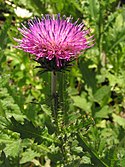
|
NYFA: X |
USDA-XX Images Wikispecies | |
ssp. pycnocephalus |
Italian thistle | Introduced, Unvouchered waif |

|
NYFA: U |
USDA-XX Images Wikispecies |
|
| |||||
Serratula
[edit | edit source]| Genus Serratula (excluded) | Plumeless saw-wort | N.Y. Status | Images | Distribution | NPT |
L. Serratula tinctoria L. |
Dyer's plumeless saw-wort, Saw-wort |
Introduced, N.Y. excluded Perennial, Herb-forb |

|
NYFA-Excluded |
USDA-X0 Go Botany-0 ITIS Images Wikispecies |
|
| |||||
Subtribe Centaureinae
[edit | edit source]The Centaureinae contains knapweeds and starthistles, none of which are native to New York, and some of which are considered to be seriously invasive in the state.[1]
Plectocephalus
[edit | edit source]| Genus Plectocephalus | Basketflower | N.Y. Status | Images | Distribution | NY NPT |
Nutt. 1821. Centaurea americana Nutt.
1830. Plectocephalus americanus in… |
American star-thistle, American basketflower, Powderpuff thistle, Thornless thistle |
Introduced from south-central US, N.Y. excluded |

|
NYFA-Excluded |
USDA-N0 Go Botany-0 ARS-GRIN ITIS BONAP Images Wikispecies |
Centaurea
[edit | edit source]The subgeneric classification of Centaurea (knapweeds) used here is based on Hilpold et al. (2014).[1]
|
Centaurea identification
[edit | edit source]Four of the most common and invasive knapweed species can often be distinguished by the involucre bracts, the scale-like structures surrounding the inflorescence, just below flower petals.[1]
|
Centaurea subg. Centaurea sect. Centaurea
[edit | edit source]| Genus Centaurea subg. Centaurea sect. Centaurea | Knapweed, Starthistle | N.Y. Status | Images | Distribution | NY NPT |
L. ssp. micranthos (S.G.Gmel. ex Gugler) Hayek 1838. Centaurea biebersteinii DC.
1872. C. australis Pančić ex A. Kern.
1907. C. maculosa ssp. micranthos Gugler
1931. C. stoebe ssp. micranthos Hayek
2003. C. stoebe ssp. australis Greuter
auct. C. maculosa non Lam.
auct. Acosta maculosa non (Lam.) Holub |
Spotted knapweed, Spotted star-thistle Centaurée maculée, Centaurée tachetée |
Introduced from southeast Europe, Highly invasive, NYIS: 79%[1], CP-3[2] NE-1[3], SNA, GNR |

|
NYFA: X |
USDA-XX Go Botany VASCAN ARS-GRIN ITIS FNA Tropicos Images Wikispecies |
L. 1753. Centaurea cineraria L.
1785. C. candidissima Lam.
1839. C. gymnocarpa Moris & DeNot.[4]
1974. Acosta cineraria (L.) Holub |
Silver knapweed, Star-thistle, Dusty miller |
Introduced from southern Europe, Impersistent, Unk. naturalization, SNA |

|
Suffolk (1921) NYFA: X |
USDA-X0 ARS-GRIN ITIS Tropicos IPN Images Wikispecies |
| Genus Centaurea (excluded taxa) | Knapweed, Starthistle | N.Y. Status | Images | Distribution | NY NPT |
Lam. 1785. Centaurea diffusa Lam.
1799. C. parviflora Desf.
1822. C. parviflora Besser hom.
1970. C. microcalathina A.O.Tarassov
1972. Acosta diffusa (Lam.) Soják |
Diffuse knapweed, White knapweed, Tumble knapweed |
Introduced, Highly invasive, NYIS: 79%[1], FEIS |

|
NYFA: 0 |
USDA-XX ARS-GRIN Tropicos Images Wikispecies |
Centaurea diffusa × C. stoebe ssp. micranthos |
Hybrid of Diffuse knapweed & Spotted knapweed |
Introduced, Highly invasive, NYIS: 79%[1] |

|
USDA-0X Images Wikispecies | |
| Jersey knapweed | Introduced, N.Y. excluded, Note[5] |

|
NYFA-Excluded |
USDA-X0 ITIS Images Wikispecies | |
| |||||
Centaurea subg. Centaurea sect. Phrygia
[edit | edit source]| Genus Centaurea subg. Centaurea sect. Phrygia | Knapweed | N.Y. Status | Images | Distribution | NY NPT |
L. 1753. Centaurea jacea L.
1778. Jacea pratensis Lam.
1799. Centaurea pratensis Thuill. (i) |
Brown knapweed, Brownray knapweed, Brown-rayed knapweed,, Brown starthistle |
Introduced, Moderately invasive, NYIS: 62%[1], CP-3[2] |
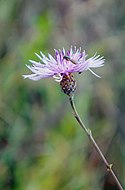
|
NYFA: X |
USDA-XX Go Botany ARS-GRIN Tropicos Images Wikispecies |
L. 1753. Centaurea nigra L.
1769. Jacea nigra (L.) Hill
1852. Centaurea nemoralis Jord.
1894. Centaurea jacea ssp. nigra (L.) Bonnier & Layens |
Black knapweed, Lesser knapweed, Common knapweed, Black starthistle |
Introduced from Europe, northern Africa, Moderately invasive, NYIS: 62%[1] |

|
NYFA: X |
USDA-XX Go Botany ARS-GRIN FNA Tropicos Images Wikispecies |
C.E.Britton Centaurea jacea × Centaurea nigra 1799. Centaurea pratensis Thuill. non Salisb.
1813. Centaurea nigra var. radiata DC.
18??. Centaurea jacea var. pratensis W.D.J.Koch
1905. Centaurea × gerstlaueri Erdner in…
1975. Centaurea debeauxii ssp. thuillieri Dostál
1921. Centaurea × moncktonii C.E.Britton in…
1926. Centaurea × jacea f. dumeticola Sennen ... |
Meadow knapweed, Protean knapweed, Hybrid of black knapweed & brown knapweed |
Introduced from Europe, Moderately invasive, NYIS: 62%[1] |

|
NYFA: X |
USDA-0X POWO ARS-GRIN Tropicos Images Wikispecies |
Willd. 1803. Centaurea nigrescens Willd.
1831. C. vochinensis Bernh. ex Rchb.
1917. C. dubia ssp. nigrescens (Willd.) Hayek
1917. C. dubia ssp. vochinensis (Bernh. ex Rchb.) Hayek |
Tyrol knapweed, Short-fringed knapweed, Short-fringed starthistle, Vochin knapweed |
Introduced from Eurasia, Moderately invasive, NYIS: 62%[1] |

|
NYFA: X |
USDA-XX Go Botany ARS-GRIN Tropicos Images Wikispecies |
L. ssp. phrygia Centaurea austriaca
C. uniflora |
Wig knapweed | Introduced, Impersistent, Unk. naturalization |

|
NYFA: Xu NYFA: ? counties GBIF ? counties |
USDA-X0 Images Wikispecies |
| |||||
Centaurea subg. Centaurea sect. Cnicus
[edit | edit source]| Genus Centaurea subg. Centaurea sect. Cnicus | Knapweed, Starthistle | N.Y. Status | Images | Distribution | NY NPT |
(L.) L. 1753. Cnicus benedictus L.
1763. Centaurea benedicta (L.) L.
1895. Cirsium pugnax Sommier & Levier
1908. Carduus benedictus Thell. (i) |
Blessed thistle, Our Lady's thistle Chardon béni, Cnicaut béni, Chardon bénit |
Introduced from Eurasia, northern Africa, Not naturalized, SNA |

|
Oswego (1883) NYFA: X |
USDA-XX Go Botany VASCAN ARS-GRIN ITIS FNA Tropicos IPN Images Wikispecies |
|
| |||||
Centaurea subg. Lopholoma
[edit | edit source] yellow knapweed |
| Genus Centaurea subg. Lopholoma | Knapweed, Starthistle | N.Y. Status | Images | Distribution | NY NPT |
L. |
Yellow starthistle, Barnaby star-thistle, St. Barnaby’s thistle |
Introduced, Potentially invasive, iMapInvasives, Invasive.org: [2], Unknonwn naturalization, SNA |

|
NYFA: X NYFA: 6 counties no counties |
USDA-XX Images Wikispecies |
| Great starthistle, Greater knapweed, Hardheads, Scabious knapweed, Greater centaury |
Introduced, Unk. naturalization |

|
NYFA: X |
USDA-XX Images Wikispecies | |
| Purple starthistle, Red star-thistle, Caltrops |
Introduced from Europe, Not naturalized, Impersistent, SNA |

|
Bronx (1898-99), Kings (1897), Queens (1879), Westchester (1894-95) NYFA: X |
USDA-XX Images Wikispecies | |
| North African knapweed | Introduced, Not naturalized, Impersistent |

|
NYFA: X |
USDA-X0 Images Wikispecies | |
| Rough star-thistle | Introduced, Not naturalized, Impersistent, SNA |

|
New York (1880) NYFA: X |
USDA-X0 Images Wikispecies | |
|
| |||||
Centaurea subg. Cyanus
[edit | edit source] bachelor’s button |
| Genus Centaurea subg. Cyanus | Knapweed, Starthistle | N.Y. Status | Images | Distribution | NY NPT |
L. (1753) 1769. Cyanus segetum Hill
1837. Centaurea pulchra DC. |
Cornflower, Bachelor’s-button, Bluebottle, Bluebonnets |
Introduced, Potentially invasive, Naturalized, Note:[1], SNA, GNR UPL-FACU Annual, Herb-forb |

|
NYFA: X |
USDA-XX Images Wikispecies |
L. 1753. Centaurea montana L.
1768. Cyanus montanus (L) Hill |
Mountain starthistle, Mountain cornflower, Mountain bluet, Perennial cornflower |
Introduced, Potentially invasive, Invasive.org: [3] |
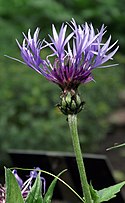
|
NYFA: X |
USDA-XX Images Wikispecies |
Carthamus
[edit | edit source] |
| Genus Carthamus | Distaff thistle | N.Y. Status | Images | Distribution | NY NPT |
L. 1753. Carthamus tinctorius L.
1753. Cathamus tinctorius L. (i) |
Safflower, Dyer's-saffron, False saffron, Bastard-saffron |
Introduced from western Asia?, eastern Med.?, Impersistent, Not naturalized |

|
NYFA: X iNat |
USDA-XX Go Botany ARS-GRIN ITIS FNA Tropicos Images Wikispecies |
L. Carthamus lanatus L. |
Woolly distaff thistle
Downy safflower
|
Introduced, Potentially invasive |

|
NYFA: 0 counties iNat 0 counties |
Go Botany Images Wikispecies |
|
| |||||
Crupina
[edit | edit source]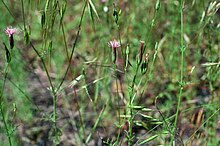 |
| Genus Crupina | Bearded creeper | N.Y. Status | Images | Distribution | NY NPT |
Cass. 1819. Crupina vulgaris Cass. |
Common crupina ⓘ
Bearded creeper ⓘ
False saw-wort ⓘ Crupine ⓘ
|
Introduced, Potentially invasive, iMapInvasives, Invasive.org: 18 listing sources, GRIIS-US: Invasive, Not listed in NYFA |

|
NYFA: not listed iNat GBIF no NY observations |
Go Botany ARS-GRIN Images Wikispecies |
|
| |||||





































